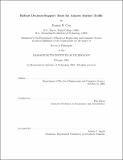Robust Decision-Support Tools for Airport Surface Traffic
Author(s)
Carr, Francis R.
Download210_Carr_PhD.pdf (963.7Kb)
Metadata
Show full item recordAbstract
Forecasts of departure demand are one of the driving inputs to tactical decision-support tools (DSTs) for airport surface traffic. While there are well-known results on average- or worst-case forecast uncertainty, it is the forecast errors which occur under best-case minimum-uncertainty conditions which constrain robust DST design and the achievable traffic benefits. These best-case errors have never previously been characterized.
Several quantitative models and techniques for computing pushback forecasts are developed. These are tested against a dataset of 17,344 real-world airline ground operations covering 3 months of Lufthansa fights transiting Frankfurt International Airport. The Lufthansa dataset includes detailed timing information on all of the turn processes, including deboarding, catering, cleaning, fueling and boarding. The dataset is carefully filtered to obtain a sample of 3820 minimum-uncertainty ground events. The forecast models and techniques are tested against this sample, and it is observed that current pushback forecast errors (on the order of §15min) cannot be reduced by a factor of more than 2 or 3. Furthermore, for each ground event, only 3 observations are necessary to achieve this best-case performance: the available ground-time between actual onblock and scheduled offblock; the time until deboarding begins; and the time until boarding ends.
Any DST used in real-world operations must be robust to this “noise floor". To support the development of robust DSTs, a unified framework called ceno-scale modeling is developed. This class of models encodes a wide range of observed delay mechanisms using multi-resource synchronization (MRS) feedback networks. A ceno-scale model instance is created for Newark International Airport, and the parameter sensitivity and model fidelity are tested against a detailed real-world dataset. Based on the validated model framework, several robust dual control strategies are proposed for airport surface traffic.
Date issued
2004-02Keywords
departure forecasting